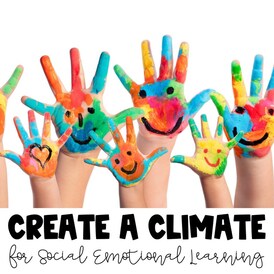 Social emotional learning is the process of children and adults achieving and effectively applying knowledge, attitudes, and skills imperative to understanding and managing emotions, setting and achieving positive goals, feeling and showing empathy for others, establishing and maintaining positive relationships, and making responsible decisions. Activities that teach and establish social and emotional skills prepare children to meet the demands of the classroom and enable students to engage fully in the classroom. Improving the entire school climate will help students with social and emotional skills as well as improve their academic skills. Below are resources that can help you implement these kinds of practices in your own classroom. Pre-K/Elementary Activities 1. Consider starting the school day with an emotional check in. You could begin by welcoming the class and asking students to describe the way they feel, use a poster to display possible emotions, or asking students an inviting question. 50 Questions to Ask Elementary Kids to Check in and Get to Know Them Better 2. Use story time to explore social-emotional themes that can be applied in your classroom. 50 Must-Have Picture Books to Teach Social Emotional Skills 3. Take time to teach kids how to work in a group; students will learn how to work with others, develop leadership skills, and identify their own strengths. Not Just Group Work – Productive Group Work 4. Role-playing. Sometimes by putting yourself in someone else’s shoes is the best way to understand troubling situations. Introduce role-playing in the classroom to help children develop empathy and understand other people’s feelings. Character Role Playing Cards Emotion and Scenario Cards 5. Peer-mediation or calm down corner. Peer-mediation is a problem-solving technique to assist students to work out problems in a private, safe, and confidential setting with a peer-mediator. You could also create a special place in your classroom known as a calm-down corner for students to take a break when upset or angry and need time to calm down. Teaching Students to Be Peer Mediators How to Create and Use a Calm-Down Corner in Any Learning Environment Middle School Activities 1. Paper Tweets creates an opportunity for students to connect with a friend or classmate to write or discuss anything they want. This should be an informal assignment and allow students creativity without being graded for their peer interactions. Paper Tweets Build SEL Skills 2. Group one-pagers are a great way for students to interact with each other and learn more about their classmates. You may consider a poster board for groupmates to create a team name, list of group favorites, and a symbol or icon for the group. Another way to create an interactive one-pager is to focus on relationship building; students may draw a picture of a classmate, friend, or teacher and three peers will give positive quotes about that person. There is opportunity for more creativity with this assignment such as – drawing funny or meaningful images, share inside jokes or memories of the person, and write a thoughtful, made-up definition of the person’s name. Using Art in Assessments 3. Student-led end-of-quarter celebrations are a great way to create class-bonding. Students have the chance to select themes, create potluck sign-ups, make invitations, and choose activities for the celebration. Examples for 17 Awesome Ways to Celebrate the End of the School Year 4. Regular class meetings produce an empowering environment that students feel heard and acknowledged. Take time to check-in with students to address issues, needs, and successes in the classroom. Creating Positive Classroom Culture with Classroom Meetings 5. Before students leave the classroom, ask exit questions that allow the teacher to assess and address the emotional needs of students. This activity is also known as an optimistic closure. 141 Exit Ticket Questions and Prompts to Check for Understanding Optimistic Closures 24 Exit Ticket Ideas High School Activities 1. To start the day, ask students to close their eyes and imagine what stress looks like and feels like in their body and prompt them to release their stress and visualize stress leaving their body. Using Visualization to Reduce Anxiety Symptoms 2. Introduce a quote of the day that is relevant to what students are learning or may experience; you can use this quote to facilitate whole-class discussion, group discussion, or a one-word response to the quote. This activity gives students time to reflect on their beliefs, morals, and experiences. 51 Motivational Quotes for Students Who Need Inspiration 50 of Our All-Time Favorite Classroom Quotes 3. Have students pair up with a classmate they don’t know and provide the students with questions to ask each other. After an appropriate amount of time has passed, each student takes turns introducing their partner to the rest of the class. 20 Questions to Get Kids Talking & Build Community 40 Weird Questions to Ask Your Students to Help You Get to Know Them Better 4. Appreciation, apology, aha is an activity that encourages students to share helpful words, authentic apologies, and realizations they may have had throughout the week. Appreciation, Apology, Aha 60-Second Strategy: Appreciation, Apology, Aha! 5. Journaling or reflective writing should be a quiet, relaxing break from schoolwork that students look forward to. 105 Writing Prompts for Self-Reflection and Self-Discovery 7 Ways Social Emotional Learning Will Solve your School Culture Challenges 5 Ways to Incorporate SEL in Middle School 25 Simple Ways to Integrate Social-Emotional Learning Throughout the Day 13 Powerful SEL Activities
0 Comments
Leave a Reply. |
AuthorWrite something about yourself. No need to be fancy, just an overview. Archives
June 2022
Categories |


 RSS Feed
RSS Feed